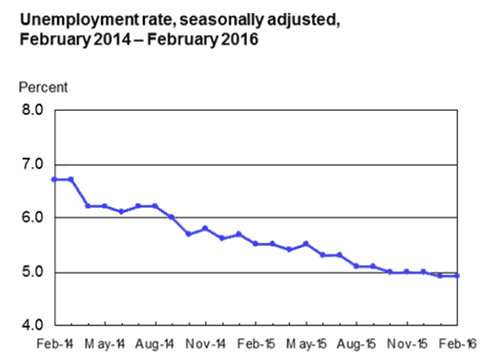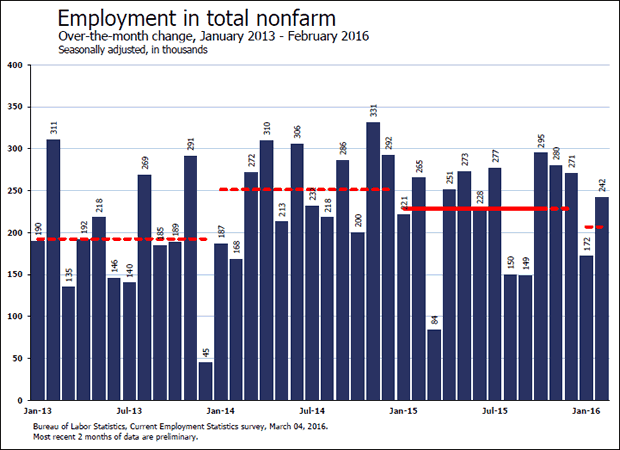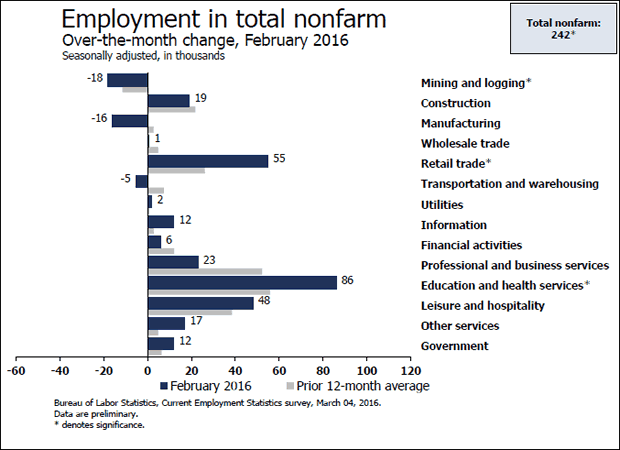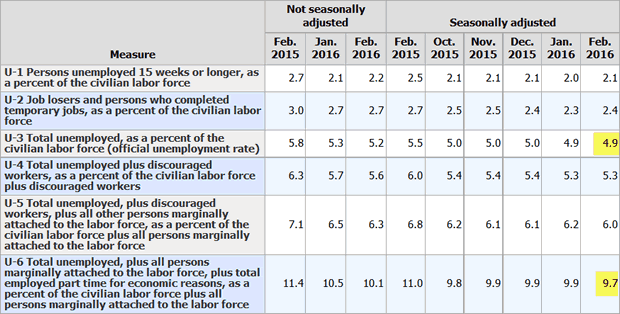US Jobs Report 242,000 Jobs: 304,000 Were Part-Time; Average Weekly Earnings Sank
Economics / Employment Mar 04, 2016 - 05:01 PM GMTBy: Mike_Shedlock
 Jobs came in well above expectations at 242,000 despite tax data collections that support a Job Growth estimate of 55,000 to 85,000 .
Jobs came in well above expectations at 242,000 despite tax data collections that support a Job Growth estimate of 55,000 to 85,000 .
A quick dive into the details shows the report is a lot weaker than the headline number indicates. Of the 242,000 jobs added, 304,000 of them were part time. That means the economy actually shed 62,000 full-time jobs.
Average hours worked declined as did average weekly earnings despite minimum wage hikes in numerous states at the beginning of the year.
First let's look at the BLS Employment Situation Summary , unofficially called the Jobs Report.
BLS Jobs Statistics at a Glance
- Nonfarm Payroll: +242,000 - Establishment Survey
- Employment: +530,000 - Household Survey
- Unemployment: +24,000 - Household Survey
- Involuntary Part-Time Work: No Change - Household Survey
- Voluntary Part-Time Work: +304,000 - Household Survey
- Baseline Unemployment Rate: No Change - Household Survey
- U-6 unemployment: -0.2 at 9.7% - Household Survey
- Civilian Non-institutional Population: +180,000
- Civilian Labor Force: +555,000 - Household Survey
- Not in Labor Force: -374,000 - Household Survey
- Participation Rate: +0.2 at 62.9 - Household Survey
Employment Report
Please consider the Bureau of Labor Statistics (BLS) Current Employment Report .
Total nonfarm payroll employment increased by 242,000 in February, and the unemployment rate was unchanged at 4.9 percent. Job growth occurred in health care and social assistance, retail trade, food services and drinking places, and educational services. Job losses continued in mining.
Unemployment Rate - Seasonally Adjusted

Nonfarm Employment Change from Previous Month

Nonfarm Employment Change from Previous Month by Job Type

Hours and Wages
Average weekly hours of all private employees fell 0.2 to 34.4 hours. Average weekly hours of all private service-providing employees fell 0.1 to 33.3 hours. Average weekly hours of manufacturers declined 0.2 to 40.2 hours.
Average hourly earnings of private workers was unchanged at $21.32. Average hourly earnings of private service-providing employees was unchanged at $21.13. Average weekly earnings of private service-providing workers fell by $2.14 to $718.48. Average weekly earnings of private workers fell by $2.12 to $684.61.
For discussion of income distribution, please see What's "Really" Behind Gross Inequalities In Income Distribution?
Birth Death Model
Starting January 2014, I dropped the Birth/Death Model charts from this report. For those who follow the numbers, I retain this caution: Do not subtract the reported Birth-Death number from the reported headline number. That approach is statistically invalid. Should anything interesting arise in the Birth/Death numbers, I will add the charts back.
Table 15 BLS Alternate Measures of Unemployment

Table A-15 is where one can find a better approximation of what the unemployment rate really is.
Notice I said "better" approximation not to be confused with "good" approximation.
The official unemployment rate is 4.9%. However, if you start counting all the people who want a job but gave up, all the people with part-time jobs that want a full-time job, all the people who dropped off the unemployment rolls because their unemployment benefits ran out, etc., you get a closer picture of what the unemployment rate is. That number is in the last row labeled U-6.
U-6 is much higher at 9.7%. Both numbers would be way higher still, were it not for millions dropping out of the labor force over the past few years.
Some of those dropping out of the labor force retired because they wanted to retire. The rest is disability fraud, forced retirement, discouraged workers, and kids moving back home because they cannot find a job.
Strength is Relative
It's important to put the strength of some of the jobs numbers into proper perspective.
- In the household survey, if you work as little as 1 hour a week, even selling trinkets on EBay, you are considered employed.
- In the household survey, if you work three part-time jobs, 12 hours each, the BLS considers you a full-time employee.
- In the payroll survey, three part-time jobs count as three jobs. The BLS attempts to factor this in, but they do not weed out duplicate Social Security numbers. The potential for double-counting jobs in the payroll survey is large.
Household Survey vs. Payroll Survey
The payroll survey (sometimes called the establishment survey) is the headline jobs number, generally released the first Friday of every month. It is based on employer reporting.
The household survey is a phone survey conducted by the BLS. It measures unemployment and many other factors.
If you work one hour, you are employed. If you don't have a job, fail to look for one and you are not considered unemployed, rather, you drop out of the labor force.
Looking for jobs on Monster does not count as "looking for a job". You need an actual interview or send out a resume.
These distortions artificially lower the unemployment rate, artificially boost full-time employment, and artificially increase the payroll jobs report every month.
In December 2015, the ECRI reported year-over-year (yoy) growth in multiple jobholders rose to an 11-month high, while yoy growth in single jobholders eased to a three-month low.
For further discussion, please see Multiple Jobholders Artificially Boost "Full-Time" Employment: Does the Sum of the Parts Equal the Whole?
Today's headline number read as "wow", but the details suggest retirees struggling to make ends meet are taking on part-time jobs.
By Mike "Mish" Shedlock
http://globaleconomicanalysis.blogspot.com
Click Here To Scroll Thru My Recent Post List
Mike Shedlock / Mish is a registered investment advisor representative for SitkaPacific Capital Management . Sitka Pacific is an asset management firm whose goal is strong performance and low volatility, regardless of market direction.
Visit Sitka Pacific's Account Management Page to learn more about wealth management and capital preservation strategies of Sitka Pacific.
I do weekly podcasts every Thursday on HoweStreet and a brief 7 minute segment on Saturday on CKNW AM 980 in Vancouver.
When not writing about stocks or the economy I spends a great deal of time on photography and in the garden. I have over 80 magazine and book cover credits. Some of my Wisconsin and gardening images can be seen at MichaelShedlock.com .
© 2016 Mike Shedlock, All Rights Reserved.
Disclaimer: The above is a matter of opinion provided for general information purposes only and is not intended as investment advice. Information and analysis above are derived from sources and utilising methods believed to be reliable, but we cannot accept responsibility for any losses you may incur as a result of this analysis. Individuals should consult with their personal financial advisors.
Mike Shedlock Archive |
© 2005-2022 http://www.MarketOracle.co.uk - The Market Oracle is a FREE Daily Financial Markets Analysis & Forecasting online publication.



